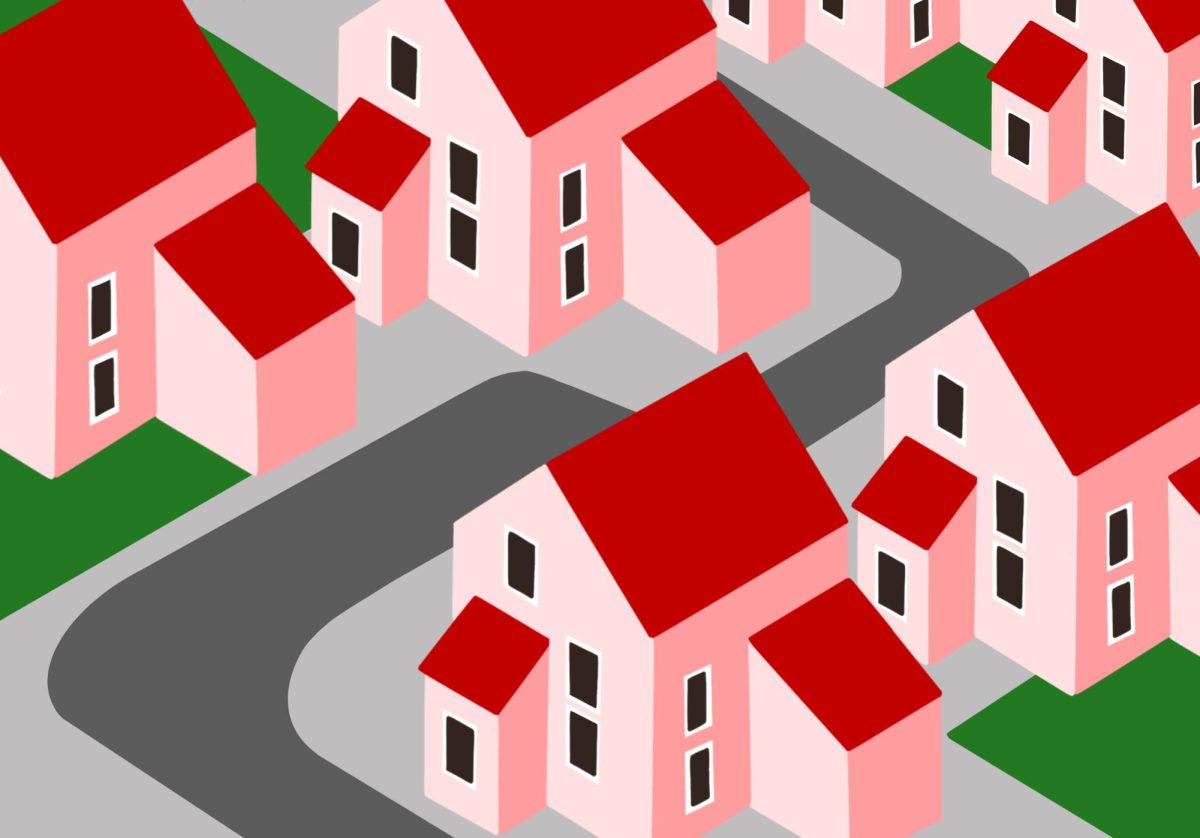In suburbia, everything is predictable.
The street patterns. Each house’s facade. Your neighbor’s complaints when your grass grows any higher than permitted by the Homeowners Association.
To many people, suburbs are society at its most pristine. Ever since emerging in the twentieth century, suburbs have frequently been compared to a utopia.
It is easy to understand why. Suburban life is calm and simple, neighborhoods are uniform and public safety is a priority.
However, suburbs have numerous design flaws that wreak havoc on transportation options, the climate and societal class division. They are solvable, but rarely addressed.
Abednett Browne, a third-year student at the University of Minnesota, said she enjoys the suburbs’ peaceful community.
“I live in the suburbs, so I prefer it over the cities because it’s quieter,” Browne said. “The city is really busy and crowded, but with the suburbs there’s more space and openness.”
Desire for extra space is a large reason why suburbs exist at all. According to Strong Towns, suburban development occurs when new neighborhoods are built outside of cities with more green lawns and distance between homes. This leads to “sprawl” — when metropolitan areas expand without restraint into surrounding land.
Sprawl alone is not necessarily a problem. However, it goes hand-in-hand with transportation issues that plague suburbs.
Hayden Da Silva, a fourth-year student at the University, said he appreciates suburbs for many of the same reasons as Browne. However, Da Silva said cars are usually the only effective method of transportation in suburbs.
“Because everything is so far apart from each other, driving is the main way to get around,” Da Silva said. “I don’t think there’s any public transit where I’m from. Walking around and biking is probably easier done in the cities.”
Getting around on foot or bicycle is more challenging in suburbs due to sprawl. However, it is possible if suburbs are designed properly.
Eric Lind, director of the Accessibility Observatory of the Center for Transportation Studies at the University, said walking and bicycling in suburbs is sometimes easy, but often limited by street design.
Suburbs are famous for loopy, indirect street patterns intended to slow down traffic, according to Lind. T often makes roads much safer, which is great for bicyclists and pedestrians.
“If you can walk or bike through the curvy streets in a way that cars can’t, that makes the environment really good,” Lind said.
Without paths that cut through neighborhoods, pedestrians are forced to follow the looping suburban streets, which makes walking indirect and excessively slow compared to driving. According to Governing, some suburban neighborhoods do not even have sidewalks because driving is universal.
Public transit is equally limited in suburbs, according to Lind.
“Transit is really good at serving dense places, and it’s hard to have density when there’s always curvy roads,” Lind said.
According to Lind, suburbs are very dependent on cars because entire neighborhoods are designed for commuters to drive to jobs elsewhere. This has several detrimental effects.
For example, too many commuters arriving by car can harm the environment of nearby urban centers, according to Lind.
“Look at downtown Minneapolis,” Lind said. “There is a tremendous amount of car infrastructure. That’s because a large number of people in 2019, pre-COVID, were driving downtown from the suburbs, even though it has great transit access. There are three enormous state-owned parking ramps in the west part of downtown Minneapolis that make it a really unpleasant place to walk around.”
Nothing is wrong with choosing to commute by car from a suburb, but suburbs are designed so little else is possible. This is a problem.
Car dependency, especially for commuting, contributes more to climate change than other methods of transportation, according to Ride Circuit. Using cars constantly is also more expensive and dangerous.
Another major issue with suburbia stems from class and racial division within different neighborhoods. According to NPR, many suburbs practiced “redlining” in the 20th century. “Redlining” legally prevents people of color from purchasing homes in certain neighborhoods.
Although these laws are no longer in the books, they have residual effects, according to NPR. Owning homes is one of the most common ways for families to build generational wealth. Many people of color were legally unable to purchase homes, contributing to economic disparity.
Today, suburban residents are still more likely to be wealthy and white than urban residents, according to a study conducted by the Russell Sage Foundation.
Suburban school districts are higher-rated and better-funded than urban schools because large amounts of school funding come from property taxes, and suburban houses are more expensive on average, according to the Russell Sage Foundation.
This is not fair. Kids should not receive higher quality public education just because they are born in a suburb.
However, none of suburbia’s flaws are without solutions.
For example, legislation could equalize school funding regardless of how wealthy the neighborhoods are. Transportation solutions already exist in some suburbs but must be more widespread.
“With biking and e-biking, there’s a real opportunity to build on successes where people have started with recreational trails,” Lind said. “People use those to get from their residences to whatever the local commercial center might be, or make a larger trip to a job.”
Public transit can be improved in suburbs with park-and-ride facilities, according to Lind. Commuters park their cars at a transit station and ride a bus or train together to the city.
Even the monotony of suburban streets can be improved with more variation in home design. Since many suburbs are designed by corporations, houses often look the same, with few opportunities for customization, according to Strong Towns.
No one wants their friend’s house to be a carbon copy of their own. Do better, corporate America.














Steve Hauser
Sep 19, 2024 at 10:32 am
I didn’t appreciate the obviously biased hit piece on the suburbs.
Public transportation is fine. Until Covid, which started “work from home” for me, getting to downtown Minneapolis from Eagan via bus was easy. I typically parked and rode, but I could walk and ride if I so desired.
Biking is safer (not more challenging) on the “curvy” suburban streets because there aren’t so many cars (aka “hazards”) parked on the streets.
The redlining comment is off base. Redlining was eliminated before middle and outer ring suburbs even existed.
The call for equalizing school funding was likely not researched beforehand. Based on the latest available data, $20,089 was spent per pupil per year at Minneapolis North, versus $12,191 at Eastview (Apple Valley) where my kids went. Disparities in academic outcomes are likely more attributable to parental involvement, and unless we are willing to outlaw two parent households, these disparities are likely to remain.
And, while your assertion that the suburbs are likely to be more wealthy is probably accurate, that wealth is not inaccessible to those who are of color. Recently, I noticed that my next door neighbors, an Ethiopian family, have a daughter, recently graduated from the U, who is driving a brand new Mercedes-Benz.
The American Dream is alive and well in the suburbs, which AREN’T broken.
Samuel Swartzendruber
Sep 18, 2024 at 12:12 pm
I appreciate the thoughtful discussion of how past redlining has had residual effects on today’s suburban demographics. How do you propose to fix this?
I disagree that equalizing school funding will solve the disparities between urban and suburban school districts. Finances are only a small part of student success, as I can attest due to my childhood in a poverty-laced neighborhood.
Equalizing measures can only come from redistribution programs, which (1) are unfair to hard-working suburban folk and (2) are unrealistic to implement.
The final line “Do better, Corporate America” is a non-sequitur. The perceived problems of suburbia cannot be attributed to some ethereal entity that ends up being an easy target to those in academia. What do you suggest that “Corporate America” do?